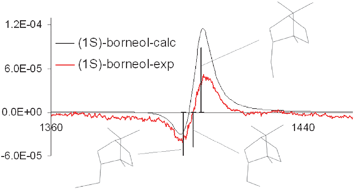Experimental and ab-initio calculated vcd spectra of the first OH-stretching overtone of (1R)-(−) and (1S)-(+)-endo-BORNEOL
Abstract
The near infrared (NIR) absorption and NIR-vibrational circular dichroism (NIR-VCD)

- This article is part of the themed collection: Celebrating the centenary of the Italian Chemical Society

 Please wait while we load your content...
Please wait while we load your content...